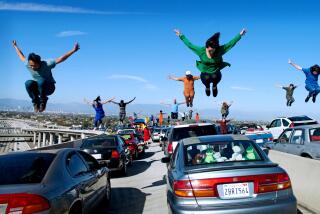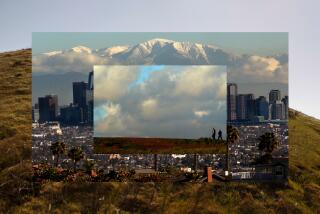Man’s quest to map L.A. points the way home
Eric Brightwell grew up in small places — a tiny town in Iowa, rural Missouri, a Florida suburb whose nearby city he barely got the chance to visit.
When he first saw Los Angeles on a post-college road trip in 1998, its hugeness floored him. There were so many people from so many countries, so many wildly different experiences within reach.
In Koreatown, he tasted fermented beans. On Olvera Street, he followed a familiar voice to find Mr. Sulu from “Star Trek,” George Takei, posing with a donkey for tourists. Friends took Brightwell to the beach and the desert and the mountains.
“I was instantly smitten,” he said of Los Angeles. “It was like a theme park where all the rides were big.”
He drove home to Iowa City to quit his job at a plant nursery and load his records and whatever else could fit into his grandmother’s beige, hand-me-down Ford Taurus.
Fourteen years later, this gentle-eyed country boy knows the L.A. area better than many natives.
He has been mapping it — section by section, city by city, neighborhood by neighborhood.
Recently he completed his 118th map, its location chosen for him by his followers on a blog.
Mount Washington won out on a list of L.A. County communities. About 800 votes were cast.
Brightwell’s maps — in Sharpie markers on colored paper — have developed a following.
The 1650 Gallery in Echo Park exhibited 40 of them last summer, pricing the 81/2-by-11 originals at $350 a pop and larger reproductions at up to $250. One original and numerous prints sold, said gallery owner Andrew Overtoom.
People pored over the images of their own stamping grounds.
They liked the lettering specific to each place — thick tree trunks for the Angeles National Forest, Disney-logo style for Anaheim.
They also appreciated the evidence of fieldwork — crease lines and crumples from being stashed in a back pocket, water stains from walks in the rain.
::
Brightwell, 38, had long made maps to orient himself. They weren’t meant for anyone else to see. In the beginning, he sometimes threw his maps of L.A. away.
He learned the area bit by bit while sharing a Silver Lake apartment and jumping from job to job.
At a custom shade factory in the Fairfax district, he cut wooden and metal rods and was driven slowly nuts by the repetitive motion. A job at a small record-store chain took him to Pasadena and Burbank. Then, when Amoeba Music opened its giant store in 2001, Brightwell headed to Hollywood.
He had majored in film studies at the University of Iowa. He hadn’t expected to make use of it. But at Amoeba, he found work in the movie department and eventually started writing for the company’s blog.
He wrote about films he’d seen, new DVD releases, big moments such as the death of Italian director Michelangelo Antonioni.
By then, Brightwell was in love. His girlfriend was a florist. Often, he joined her as she was making deliveries. Why not, he thought, explore the places they went, look up history and landmarks, offer a sort of hyperlocal travel guide?
In the first post, on Granada Hills, he mentioned that Soviet Premier Nikita Khrushchev had visited in 1959, when he was taken to see a modern American suburb. He posted photos of Granada Hills houses designed by Joseph Eichler and one of O’Melveny Park, the second-largest park in the city.
To tie in with Amoeba, he offered a neighborhood filmography: “Fast Times at Ridgemont High,” the opening of “Knots Landing,” a helicopter crash in the fifth episode of the TV show “24.”
Montebello was next, then Alhambra. He started taking photos and posting them, and then adding a local version of the mapping he’d been doing on and off since childhood.
::
The first maps Brightwell ever made were of the eight country acres of trees and trails outside his boyhood ranch house in Missouri.
On paper, Brightwell magically transformed that familiar world, turning one tree into a witch’s lair, another into a huge dinosaur leg. A fallen trunk became a shipwreck. Treasure was buried everywhere.
He was 8 or 9 at the time, a child who mostly kept to himself.
Adults often were absent. His father had left the family when he was 6. His mother worked long hours as a nurse.
Brightwell, who always loved the old-fashioned, lived in a fantasy world, engrossed in his father’s old Famous Monsters of Filmland magazines and books with elaborate imaginary worlds mapped on their endpapers.
At school, he would sit reading alone at lunch. At home, he spent hours trying to solve text-based computer games.
The screen would be black except for a choice: “You’re facing north. There’s a door to the east and a door behind you. What do you do?”
If he moved the wrong way and was told he’d fallen into a pit, he would map the pit’s location to avoid it next time.
Mapping let him skirt invisible trapdoors and dungeons.
It helped him later on, too, in real life.
Brightwell was 15 when his mother was diagnosed with breast cancer. She died on Christmas Day in 1990.
He and his younger brother were shipped off to a suburb outside Tampa, Fla., to live with their father, his new wife and their new children.
The new wife didn’t want them there.
When the new children had friends over, the Brightwell boys were locked in their rooms. Each night, after the new family had finished dinner, the boys were summoned by intercom to eat the often paltry leftovers.
Before they were welcomed in by their mother’s relatives in Iowa, the brothers were stuck in the Florida suburb, nurtured by no one, taken nowhere.
Hansel and Gretel dropped bread crumbs to find their way back home. Brightwell sketched maps leading away from a home that wasn’t one.
::
In L.A., one map followed the next as Brightwell crisscrossed the area, sometimes by foot and by bike.
He described more and more about what he saw in his blog posts, and began stopping to talk to people in the neighborhoods he visited. He learned why the first Bangladeshi businessmen settled in Little Bangladesh. He spoke to a man with blessings for sale in Morningside Circle.
His maps also became more fanciful.
In the compass roses, which orient north, south, east and west, Brightwell began adding drawings. Santa Ana, for its famed winds, got a gust beneath a cloud. Pomona got a hand dangling an orange by its stem, in honor of the Roman goddess of fruit trees.
For his friends, Brightwell zoomed in and drew micro-maps — highlighting a favorite taco stand, the houses of people they knew.
He also began drawing larger maps of big, often self-defined areas: South L.A.’s Eastside, South L.A.’s Westside, the Mideast Side — a tongue-in-cheek label for those west of downtown who call themselves Eastsiders.
Once he’d stared at seas of streets on Thomas Guide grids, unable to see a whole in the profusion of detail. Now in his head, disparate parts began coming together — a complex jigsaw puzzle on the verge of being solved.
Los Angeles started to feel like home, and Brightwell was putting down roots.
He envisioned a house and a family. He was saving money for a down payment.
Then, about two years ago, he and his girlfriend broke up. He was devastated.
It took a long time, and another big life change, for him to again find his bearings.
Brightwell had left his job at the Amoeba store — though he was still writing for, and posting maps on, the blog.
He put all his maps online as a body of work, under the suitably old-world name Pendersleigh & Sons Cartography. He took his nest egg and re-purposed it to open a Silver Lake “gentleman’s shop.”
Cotton ties hang like prayer flags in the front window. On the shelves and tables are soaps and salves, colognes, wallets and striped socks.
On the walls and in a thick stack next to a selection of guitar straps are rainbows of Brightwell’s maps. They are striking views of little places rarely shown alone.
Wilshire Center, Bunker Hill, Canterbury Knolls, a wonderfully pork-chop-shaped Elysian Park.
On a recent afternoon, two young men entered the store, drawn by its retro vibe. One noticed the maps and began moving from one to the next, his voice full of excitement. He said he’d read about the maps on a blog, that they were famous.
“I really want to meet the guy who makes these,” said Malcolm Miller, 24, of Echo Park.
Behind the counter came a slightly bashful smile.
More to Read
Sign up for Essential California
The most important California stories and recommendations in your inbox every morning.
You may occasionally receive promotional content from the Los Angeles Times.











